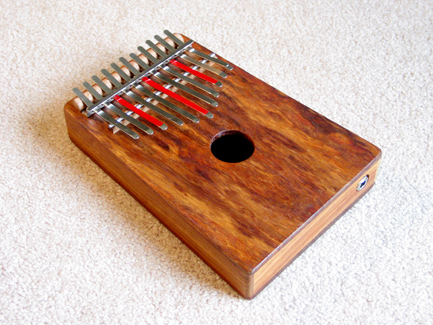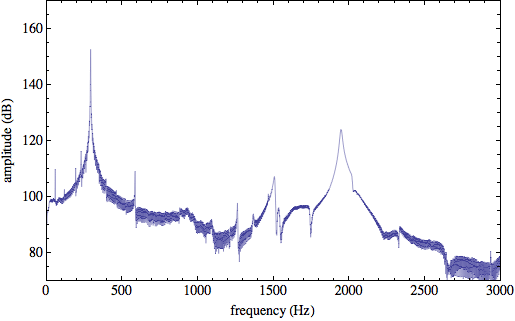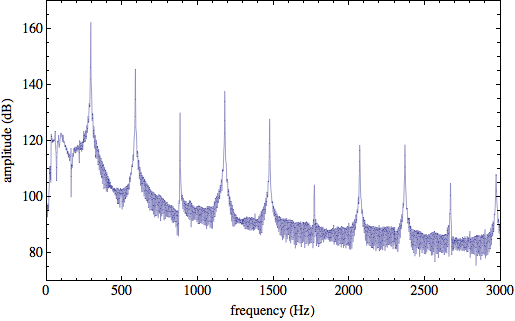


The Sound of the African Thumb Piano (kalimba)
David M.F. Chapman - dave.chapman@ns.sympatico.ca
Scientific Consultant
8 Lakeview Avenue
Dartmouth, Nova Scotia
B3A 3S7, Canada
Popular version of paper 5aMUf1
"Characterizing the sound of an African thumb piano (kalimba)"
Introduction
The African thumb piano, or kalimba (also called by other names) is an unusual percussion instrument consisting of a number of thin metal blades (keys) mounted on a soundbox or soundboard. The keys are mounted with different free lengths to produce different notes, and they are typically struck at the end by the performers thumbs while the soundbox is held by the fingers. The instrument used for this study was the Hugh Tracey Pentatonic Kalimba (with pickup).

Figure 1: The Hugh Tracey Pentatonic Kalimba
Sound 1: A pentatonic major scale played on the kalimba
Analysis
The individual notes of the kalimba were recorded and analysed to determine their overtone structure. The notes have a sharp attack with a slight discordant edge, followed by a slowly decaying pure tone. The dominant tones of a note are: a strong fundamental frequency (f0) and a single overtone (f1) whose frequency ratio f1/ f0 is about 5.9-6.8. (There are also higher-frequency, less significant, overtones.) Overtones that are not exact integer multiples of the fundamental are called anharmonic, as they do not aurally blend with the fundamental in a pleasing manner. In the case of the kalimba, the anharmonic overtones die away rapidly, so their effect is only heard at the instant the note starts.
Sound 2: The sound of the kalimba note D4 (i.e. the fourth D note on the 88-key piano)
Contrast this kalimba note with same note played on the guitar, which generates sound with a taut, vibrating string. The vibrating string, also used in the violin family of instruments, has a sequence of harmonic overtones whose frequencies are integer multiples of the fundamental.
Sound 3: The sound of the guitar note D4
Instruments such as the pipe organ and the flute, whose sounds are generated by vibrating columns of air, also have harmonic overtones.
The overtone structure of both the kalimba note and the guitar note can be visualized by examining the frequency spectra of these sounds. Note the sparse, anharmonic overtones of the kalimba in contrast with the rich, harmonic overtones of the guitar.

Figure 2: The frequency spectrum of note D4 played on the kalimba.

Figure 3: The frequency spectrum of note D4 played on guitar
Synthesizing kalimba sounds
Using these facts, one can construct a synthetic kalimba sound from the sum of two exponentially damped sinusoids. By aurally comparing true and synthetic waveforms, it is possible to adjust the few model parameters to produce a realistic-sounding synthetic waveform.
Sound 4: The sound of the real kalimba note D4
Sound 5: The sound of the synthetic kalimba note D4
Summary of technical analysis
The full presentation shows details of the geometrical and acoustical measurements of all the kalimba keys. The key is physically modeled as the vertically transverse vibrations of a thin beam that is clamped at one end, supported part way along its length, and free at the far end. The overtone frequency ratios f 1/ f 0 and f 2/ f 0 are correlated with the subdivided lengths of the vibrating beam. Given the simplicity of the model, the agreement between measured and modeled frequency ratios is very good.
Further information on the kalimba
1. Mathematician and musician Nhamburo Ziyenge uses the kalimba and other African instruments to teach young children: http://www.bbc.co.uk/videonation/articles/o/oxford_instrumentoflearning.shtml
2. An example of contemporary music employing the kalimba: “Kalimba,” by Laraaji Nadananda, in Brian Eno, Music for Films III (All Saints Records, 1988), http://www.allsaintsrecords.com/hncd_1488.htm
3. Distributor of kalimbas, kalimba music, and instructional aids: Kalimba Magic, P.O. Box 12974, Tucson AZ 85732, www.kalimbamagic.com